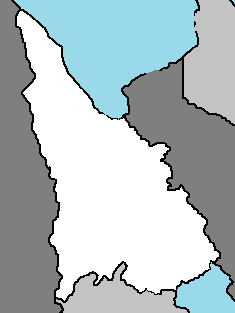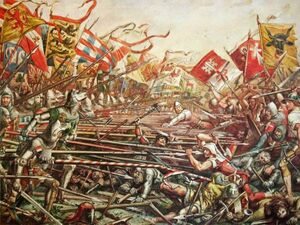Marcisia
The Principality of Marcisia | |
|---|---|
|
Flag | |
| Motto: Rich nation, strong army | |
 | |
| Capital | Veramento |
| Official languages | Latin Gaulish |
| Government | Unitary constitutional elective principality |
• Prince | Alexandre I |
| Establishment | |
• Cyrasenic Dynasties | c. X century BCE |
• Mycrasian Empire | 24 BCE |
• Feudal Confederation | 1243 |
• Marcisian Social State | 1929 |
• Republic | 1947 |
• Principality | 2021 |
| Population | |
• 2021 estimate | 25,417,100 |
| GDP (PPP) | estimate |
• Total | 499.192 billion |
• Per capita | 19,598 |
| Currency | Marcisian Mark |
Marcisia, formally the Principality of Marcisia, is a sovereign country in Central Adula, bordered by Kossmil to the east and Wyomia to the south. Veramento is the country's capital and largest city.
Marcisia is a unitary constitutional elective principality with Prince Alexandre I as the head of state and government. The Prince of Marcisia is elected for life by national popular vote.
The National Assembly is the highest legislative body and holds general elections every 4 years through first-past-the-post constituencies.
The executive power is lead by the Prince and his ministers. The ministers are exclusively selected by merit from the state bureaucracy. The head of government may dismiss any member of his cabinet but he doesn't possess the authority to appoint them. State bureaucracy choose their ministerial leadership by direct secret ballot.
Some scholars have described the Marcisian political system as a form of plebiscitary technocracy or technocratic democracy.
On 7 September 2021, Marcisia became a full member of the Coalition of Crown Albatross.
History
Early dynastic rule
The most archaic historical evidences from today's Marcisia are situated in the northern shore of Lake Ellin. Ceramic items, metal works, mosaics and specially tombs revail the way of life of the Cyrasenic culture, the first native civilization.
First writing sources are dated since the 1090 BCE. Popular songs, folkloric poetry and annals of noble households enlighten some characteristics of this early period.
A hundred ruling dynasties and almost fifty proto-languages can be classified by modern historiography belonging to the ancient era.
From the second half of the V century BCE, the expansion of trade and improvement of infrastructures flourished the economy. Strengthened noble dynasties upgraded their military, crushed other households and expanded their states, polarizing the realm.
In the 98 BCE, three powerful families clashed on a massive war for domination known as the Dance of the swans. It's the bloodiest conflict in the history of ancient Marcisia. In 36 BCE, the northern state of Mycrasia submitted southern Cyras and western Collania, uniting vast territories under one king.
Mycrasian Empire
In 24 BCE, following problems of succession due to a lack of a proper heir, the head of House Mycrasia adopted a young loyal courtier as heir and declared the Mycrasian Empire.
The empire, institutionalized as a succession of rival noble houses and high ranking military, long lived for almost a millenia, shaping Central Adulan world.
In the X century, infighting and pressure from eastern nomads and Nortuans settlers broke up the empire until its final collapse in 949 CE.
Feudal confederation
For over a century since imperial collapse, pillaging, aggression and famines became common. Trade routes disappeared and diplomacy with foreign states minimized. Power vacuum in the region attracted chieftains from Adula and beyond, establishing independent petty kingdoms all over Marcisia.
Mixing of people and culture vulgarized the imperial Latin language, with distant ones, specially gaulish.
With the turn of the XI century, primitive relations between lords and reopening of rudimentary routes slowly developed.
In 1079, King Roiland The Red expelled all nortians tribelords from the north Marcisian coast.
On October 1243, a century lasting war between the League of Marcisia and the Kingdom of Harles ended in a pyrrhic victory for the former, which established a territory with no kings and over twenty semi independent states. They were ruled by an elected lord protector.
During the XVIII century, Duke Louis of House Mitford became protector of the realm and, along his son Duke Charles, instrumentalized feudal institutions to gain de facto supremacy through all the realm.
House Mitford became a rich duchal lineage since the XVII century, with eyes and whispers in every Marcisian court. Using bribery, plotting and intimidation, they developed a clientelistic network that submitted rival lords and monopolized military power until 1947.
On Christmas eve 1927, an unidentified organization crashed a zeppelin full of explosives in the Winter Palace, killing 656 people. Among the victims were the Duke of Veramento and his wife, 4 out of their 6 children, 93 top army officials, 229 servants and over 300 Marcisian nobles. It's the deadliest terrorist attack in Marcisia history.
From Christmas 1927 to May 1929 military command seized total power. Loyalist general Larossa assumed regency until the coming of age of Celine Mitford, heir and second youngest daughter of the deceased Duke of Veramento.
Social State
Lady Celine of House Mitford reached the age of 16, inheriting the duchy of Veramento, on May 4, 1929.
After the Christmas attack, following economic hardships and security concerns, Marcisians felt morally devasted and the feudal-like state was losing legitimacy to rule. To capitalize power and restore order, loyalists advised Lady Mitford to instaure a modern unified state, ending feudal relations and inspiring national support of the masses.
In the night of the 25th of December, two years after her family murder, Duchess Celine installed the Marcisian Social State. It was a totalitarian fascist regime, founded by nationalistic values, royal purity and imperial reawakening.
The Social State adopted massive social policies. There was a huge persecution of ethic minorities, homosexuals, political opposition and rival top military officers. Traditional values and cult of personality were promoted as tenents of society. Lady Mitford was revered as a living god.
From 1935, following a nation-wide rearmament and construction of big infrastructures, Marcisia started an aggressive territory expansion.
In 1941, southwest Kossmil, torned by internal conflicts, was invaded by Marcisia and subsequently annexed. From late 1942, the Social State faced resistance in the region from oppressed orthodox slavic populations, that had been called to arms by the Slavic Union's funded Black Brigade. Although the puppet state of Leniya, administered by slavic catholics, was established in 1943 to contain orthodox rebellion in Kossmil, several war fronts constrained the Social State efforts.
On December 7, 1945, surrounded and demoralised, the last Marcisian forces surrended to the Black Brigade. The slavic rebellion ended with Duchess Celine's claims to the east, losing the marine monopoly on Lake Ellin.
Meanwhile, partisan activity inside Marcisia, although existing since the late 30s, intensified its attacks and ambushes to the fascist establishment from 1945. Due to growing distrust on Mitford leadership and costly defeats in military incursions, many military squads at the front started to desert and rebel. In 1947, the situation was on the brick of civil war, with a menacingly communist partisanship and near border collapse. On May 28, Celine Mitford committed suicide and her sister Hélène went to exile.
Republic
After the Duchess downfall, military cliques negotiated with partisans to plan the creation of a republic, to cope with foreign pressures. Communists, although greater in numbers, possessed fewer resources and had become secluded in rival factions. On July 25, 1947, a provisional government made of several political forces except communists, declared the fall of the Social State and the upcoming celebration of free open elections for a new republic.
To shut down the communist threat and minimize factionalism, political parties were banned and candidates were required to contest as independents in single constituencies. This political party ban remains to this day.
Although republican institutions remained stable, with no inner conflicts, diplomatic relations worsened and the Marcisian economy stagnated for over five decades. The Republic of Marcisia long-lived as a developing isolated nation, with a import substitution policy of almost autarchy until 1964. Export lead policies became to develop at the turn of the century, but political distrust and pervasive corruption pervived.
The Principality (2021-present)

By winning popular support, captain aviator turned President, Alexandre La Valle successfully changed the status of Marcisia to a principality, undermining parliamentary power and getting elected as Prince for life.





